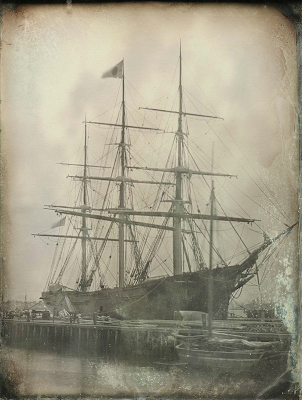Cf. pages 72-73 of your DNL textbook (Lesson 1):
3rd millennium BC: trade links between Sumer and the Indus Valley, also the Egyptians traded spices with the Middle East;
6th century BC: the Greeks start to found colonies;
4th century BC to 5th century AD: the Roman Empire;
2nd century BC: the Silk Route
from China to the Mediterranean traced (click HERE!);
1295: Marco Polo returns to Venice after a long sojourn in China, laden with silk and jewels and tales of the fabulous wealth of the Orient. His exploits rekindle a long-dormant interest in trade between Europe and the East;
1492: Christopher Columbus discovers America;
16th and 17th centuries: rise of Portuguese, Spanish, Dutch and British maritime empires;
1600: the British East India
Company, the first multinational corporation, was founded (the Dutch East India
Company was set up in 1602);
1854: Donald McKay's Boston yard launches fast sail ships;
19th century: the transport revolution (rail, steamships, and canals) allowed more goods to be transported quicker and further so that they became cheaper, more diverse and plentiful. The transport revolution, industrialization, and colonization encouraged the creation of many companies with interests throughout the world (dominated by the British);
1914: the outbreak of World War I ends the first great age of globalization, when trade and international investment had boomed;
1947: creation of the GATT (General Agreement on Tariffs and Trade), a multilateral agreement to reduce barriers to international trade;
1948: the Marshall plan helps Europe rebuilt and creates dependency on the USA;
1950s onwards: start of the reign of the multinational firms and of free trade on an international scale (except for countries under control of the Soviet Union);
1956: Malcom McLean developed the shipping container which revolutionized international
transport;
1970: Boeing 747 jumbo jet makes intercontinental air travel accessible to a mass market;
1980s: improved telecommunications networks (start of Internet);
1991: collapse of the Soviet Union, the USA becomes the hyper power and the free market spreads to all parts of the planet;
1995: the GATT is replaced by the WTO (World Trade Organization);
1999: riots at the World Trade Organization meeting in Seattle signal a backlash against free trade;
2001: China joins the WTO, hence integrating its economy into international trading patterns;
2007: start of the Great Recession;
2012: Russian Federation joins the WTO.
Comments on document 2 (Purchasing
and manufacturing globally: Toyota):
TNCs are the driving force of globalization, its main vector. Toyota is (like Ikea) a good example of
a multinational firm. This text, from the company’s website, explains its successful
strategy.
Toyota Motors is a Japanese firm set up in 1933. It has been a multinational
corporation since the 1950s (“corporation” means a group of people authorized
by law to act as a legal personality and having its own powers, duties and
liabilities). Toyota is based (has its headquarters) in Toyota City, Japan, and its
production plants in 26 countries.
Toyota Motors is today one of the biggest car manufacturers in the world. There is wide-spread diffusion (it sells in 170 countries) of its mass-produced vehicles. According to the text, which obviously presents the firm in a positive light, Toyota’s
strength is due to its knowledge of its clients’ needs all over the world. It produces all over the world, non-stop, and adapts
its products to local needs using local labour and materials. Its managers are
Japanese and the firm has been able to make local personnel adapt to its
production and management methods (the Japanese managers have intercultural management skills).
Comments on document 3 (map of The world archipelago):
This map
shows the major transport routes for worldwide trade.
The word “archipelago”
is used to describe the continents as if they were part of a group of interdependent
“islands”, the suppliers and consumers of the different countries united by
globalization. It is a way of describing a world that is highly interconnected
and interdependent though trade.
An “oligopoly”
is a market in which control of a commodity is in the hands of a small number
of businesses which can influence prices and affect weaker competitors. It
describes the countries of the Triad (the USA, Western Europe, Japan).
The map shows exchange of goods by air (air freight)
and sea routes; exchange is mainly between the Triad regions.
Petrol tankers, giant container and cargo ships go towards
Japan and China, and around Africa towards Europe, and to North America from
Europe and the Far East.
Singapore, Hong Kong, Shanghai, Osaka, etc. are major
ports. There are major ports in Europe and the USA. Ports are where most exchange
takes place. The Panama and Suez canals are strategic areas, as are the Straits
of Hormuz, Malacca and Magellan, and the Mozambique Channel.
The megalopolises are transport hubs (i.e. major centres
of transport networks).
Comments on document 4 (Bollywood out to conquer the world):
The poster
advertising a Bollywood film poster exhibition illustrates the globalization of
culture.
Mumbai (previously
called Bombay) is in India. It is the city in which many films are produced
(more than in Hollywood, USA). The films produced in Mumbai are called “Bollywood”
movies (mixture of the words “Bombay” and “Hollywood”). They are mostly watched
in Asia and Africa, but are also becoming popular in other parts of the world
(not just because of the expatriate Asian communities).
Films are a
powerful means of spreading cultural models throughout the world. The growing
popularity of films from India proves that Western cultural
products do not entirely dominate the world.
“Slumdog
Millionaire” is a British film set in India inspired by Bollywood-style cinema; it
won the 2009 Best Picture Oscar.



No comments:
Post a Comment